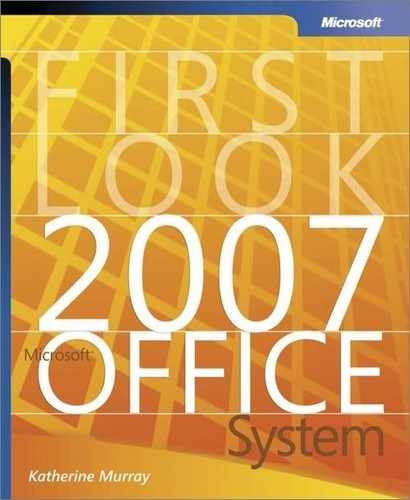Understanding the Workspace Window
The Office Groove 2007 workspace window is organized to help you navigate easily among all your team communication and project tasks (see Figure 11-3). The title bar of the open workspace window displays the name of the current workspace; the familiar menu bar offers commands for managing files, working with tools, changing the view, and setting preferences. Use the Workspaces button on the menu bar to move among your various workspaces. The context-sensitive Common Tasks pane in the lower-right corner of the workspace also offers useful functions based on where you are in the workspace or what you’ve clicked.
Figure 11-3. The Office Groove 2007 workspace includes tools to share files, host a discussion, and chat live.

If you create a Standard workspace, which is the most common way to begin a workspace, it automatically contains a Files tool and a Discussion tool. When you open the workspace, the Files tool is selected by default, and a set of buttons for working with files stretches across the top of the work area. Each tool has its own unique menu button just below the familiar Windows-style menu options. At any time during your project, you or your team members (depending on the permissions you’ve set) can add a variety of additional tools to your workspace (which you’ll learn about in the next section).
The Workspace Members task pane on the right side of the window displays team members who are currently online and the Invite To Workspace box. The workspace called the Chat pane is just below the Workspace Members pane, and can be opened and closed using the up and down arrows.
Inviting Others and Assigning Roles
Inviting others to join your workspace is a simple task in Office Groove 2007. Simply click the Invite To Workspace box, type your contact’s name or e-mail address, and click Go. (If you’ve entered the contact’s information previously, the address will appear automatically before you finish typing it.) The Send Invitation dialog box appears so that you can add additional invitees, select roles, add a message, and click Invite (see Figure 11-4). Recipients who have Office Groove 2007 will receive the invitation that way. Those who do not will receive an e-mail message with the links they need to get started.
Figure 11-4. When you invite others, you can specify their roles and add a customized message.

Office Groove 2007 enables you to assign three different roles to workspace members. As the creator of the workspace, you are by default a Manager and have all workspace-level permissions, including inviting or uninviting members and adding and deleting tools. Each member invited to a workspace is given a Participant role by default, which typically allows them to invite new members and add tools. The Guest setting restricts members to read-only privileges, so they cannot add to or delete information in the workspace or invite others.
Tip
Office Groove 2007 and Data SafetyIs Office Groove 2007 safe? Many users today are concerned—and rightly so—about the safety of their information, particularly when they are working in an online collaborative group. Office Groove 2007 automatically encrypts all information shared within workspaces, both on team members’ desktops and as the data passes over the company network or the Internet. |
